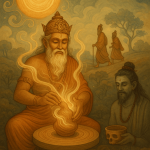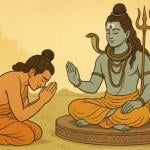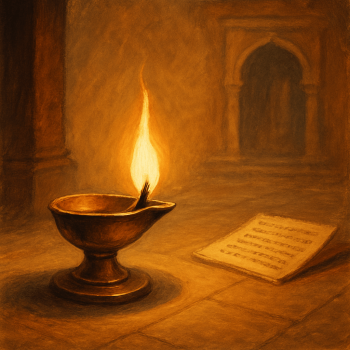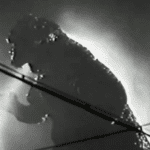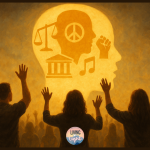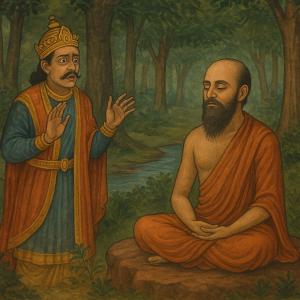
Vedantic teachings, drawn from the Upanishads and expanded upon in texts like the Bhagavad Gita, often speak in abstract, profound truths about the Self, the illusion of the world, and the path to liberation. But these truths, when told through stories, become accessible, engaging, and unforgettable. The tale of Bharchu, a wise minister betrayed by envy and ultimately transformed by reflection, is one such story that shines with the timeless wisdom of Vedanta.
Bharchu’s Journey: From Devotion to Detachment
Once, in a faraway kingdom, a loyal minister named Bharchu faithfully served his king. Though the king trusted him, other jealous ministers plotted against him. They hired bandits to cause chaos, then cunningly suggested Bharchu handle the crisis. Bharchu went alone, defeated the threat, and restored peace.
But while he was away, the schemers declared him dead and claimed his post. The king believed them. When Bharchu learned of this betrayal, he was not filled with revenge—but sorrow and reflection. He questioned the worth of his efforts, the meaning of praise, family, power, and wealth. Realizing their impermanence and the sorrow they bring, he renounced everything and retreated into the forest.
There, Bharchu lived simply and found profound peace. Years later, the king saw him meditating, but, blinded by fear and rumors, mistook him for a ghost and fled. Bharchu simply smiled, free from all need for recognition.
Vedantic Insights Through Bharchu’s Realization
a. Maya and Avidya (Illusion and Ignorance)
The king, once wise, becomes a victim of maya (illusion) and avidya (ignorance). He believes lies, forgets truth, and becomes terrified of Bharchu’s presence. This reflects how easily truth can be veiled when one clings to false narratives.
b. Raga, Moha, and Dukha (Attachment, Delusion, and Sorrow)
Bharchu’s sorrow arises from raga (attachment) to name, reputation, and comfort, and moha (delusion) about their permanence. His spiritual awakening begins when he questions these attachments.
c. Vairagya (Dispassion) and Viveka (Discrimination)
Through solitude and contemplation, Bharchu develops viveka (discrimination between real and unreal) and vairagya (detachment). He realizes the futility of chasing approval and power.
d. Sannyasa and Inner Freedom
Bharchu’s renunciation isn’t escape—it’s elevation. In Vedanta, sannyasa (renunciation) isn’t about outward change but inner clarity. By walking away, Bharchu walks inward, toward the Self.
The Forest and the Palace: Two Worlds, Two Realities
The palace represents ambition, ego, and social illusion. The forest is the space of inner work, solitude, and nature’s harmony. Vedantic literature often places the seeker in the forest—not because the world is bad, but because silence is needed for Self-realization.
The King’s Arc: Lost in Fear, Bound by Illusion
While Bharchu evolves, the king regresses. His fear shows how avidya causes one to misinterpret reality. The once-wise ruler cannot see the truth before him. His power and pride become his prison.
The king’s journey reminds us that leadership without inner clarity leads to blindness. Trust clouded by insecurity breeds poor judgment. Even with material power, he lacks the spiritual vision to recognize truth and goodness.
Learnings from the King’s Path:
- Trust must be anchored in discernment, not hearsay.
- Fear thrives when ignorance prevails.
- Even a great king can fall when guided by falsehood.
- Without self-reflection, power corrupts more than it protects.
Bharchu in Our World: A Mirror for Modern Minds
In today’s world, many of us are Bharchu—working hard, loyal, chasing success and praise—until life betrays us. Whether through job loss, relationship breakdowns, or health issues, the illusion breaks. Like Bharchu, we can either fall into bitterness or choose wisdom.
Ask yourself:
- What am I attached to that brings more worry than joy?
- Do I seek approval or inner peace?
- What would happen if I let go of my need to be seen, praised, or remembered?
Bharchu’s story invites us to pause, reflect, and perhaps walk into our own metaphorical forest—where true peace awaits.
The Silent Smile of Liberation
Bharchu’s final smile is the smile of one who has seen through illusion. He has no resentment, no desire for restoration, no fear. He is established in the Self. This smile is the fruit of Vedantic wisdom: freedom not from the world, but from dependence on it. He has moved from palace to peace—and shown us the path, if we dare to follow.
“Ayam Ātmā Brahma” – Mandukya Upanishad, 2
(This Self is Brahman.)


